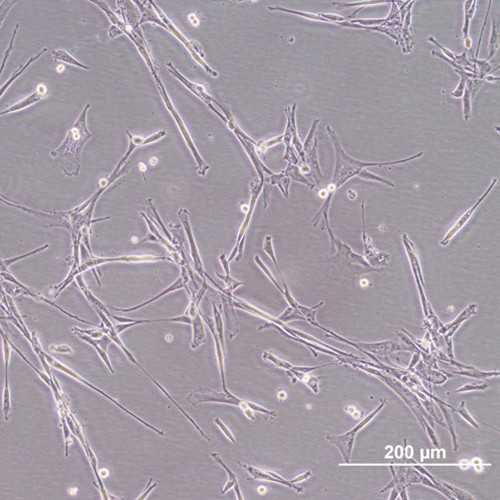Canine Hemangiosarcoma Cell Line (EFB)
EFB is a canine hemangiosarcoma cell line derived from a metastatic tumor in the brain of a 9-year old spayed female Golden Retriever.
Hemangiosarcoma is a rapidly growing, highly invasive variety of cancer, occurring commonly in dogs. It is a sarcoma arising from the lining of blood vessels. A frequent cause of death is the rupturing of this tumor, causing the patient to rapidly bleed to death.
From the laboratory of Jaime F. Modiano, VMD, PhD, University Minnesota, Twin Cities.
EFB is a canine hemangiosarcoma cell line derived from a metastatic tumor in the brain of a 9-year old spayed female Golden Retriever.
Hemangiosarcoma is a rapidly growing, highly invasive variety of cancer, occurring commonly in dogs. It is a sarcoma arising from the lining of blood vessels. A frequent cause of death is the rupturing of this tumor, causing the patient to rapidly bleed to death.
From the laboratory of Jaime F. Modiano, VMD, PhD, University Minnesota, Twin Cities.
This product is for sale to Nonprofit customers only. For profit customers, please Contact Us for more information.
Specifications
| Product Type: | Cell Line |
| Name: | EFB (Emma-brain) |
| Cell Type: | Hemangiosarcoma |
| Accession ID: | CVCL_0C96 |
| Organism: | Dog |
| Source: | Brain, Derived from paired metastatic lesion with cell line EFS that share common markers with the affected dog's constitutional germline DNA. IDEXX Bioresearch authentication ID IBR-36349-17-1 |
| Morphology: | Spindle |
| Biosafety Level: | 2 |
| Subculturing: | Split 1:2-1:3 when cells reach ~80% confluence |
| Growth Conditions: | Ham's F12, 10% FBS, 0.05mg/ml ECGS, 0.01mg/ml heparin, 10mM HEPES Buffer, 100ug/ml Primocin |
| Cryopreservation: | 90%FBS/10% DMSO |
| Mycoplasma Tested: | Yes |
| Storage: | Liquid nitrogen |
| Shipped: | Dry ice |
Provider
From the laboratory of Jaime F. Modiano, VMD, PhD, University Minnesota, Twin Cities.
References
- Tamburini BA, Trapp S, Phang TL, Schappa JT, Hunter LE, Modiano JF. Gene expression profiles of sporadic canine hemangiosarcoma are uniquely associated with breed. PLoS One. 2009 May 20;4(5):e5549. doi: 10.1371/journal.pone.0005549.
- Tamburini BA, Phang TL, Fosmire SP, Scott MC, Trapp SC, Duckett MM, Robinson SR, Slansky JE, Sharkey LC, Cutter GR, Wojcieszyn JW, Bellgrau D, Gemmill RM, Hunter LE, Modiano JF. Gene expression profiling identifies inflammation and angiogenesis as distinguishing features of canine hemangiosarcoma. BMC Cancer. 2010 Nov 9;10:619. doi: 10.1186/1471-2407-10-619.
- Schappa JT, Frantz AM, Gorden BH, Dickerson EB, Vallera DA, Modiano JF. Hemangiosarcoma and its cancer stem cell subpopulation are effectively killed by a toxin targeted through epidermal growth factor and urokinase receptors. Int J Cancer. 2013 Oct 15;133(8):1936-44. doi: 10.1002/ijc.28187. Epub 2013 Apr 25.
- Stiles JM, Amaya C, Rains S, Diaz D, Pham R, Battiste J, Modiano JF, Kokta V, Boucheron LE, Mitchell DC, Bryan BA. Targeting of beta adrenergic receptors results in therapeutic efficacy against models of hemangioendothelioma and angiosarcoma. PLoS One. 2013;8(3):e60021. doi: 10.1371/journal.pone.0060021. Epub 2013 Mar 28.
- Gorden BH, Kim JH, Sarver AL, Frantz AM, Breen M, Lindblad-Toh K, O'Brien TD, Sharkey LC, Modiano JF, Dickerson EB. Identification of three molecular and functional subtypes in canine hemangiosarcoma through gene expression profiling and progenitor cell characterization. Am J Pathol. 2014 Apr;184(4):985-95. doi: 10.1016/j.ajpath.2013.12.025. Epub 2014 Feb 11.
- Khammanivong A, Gorden BH, Frantz AM, Graef AJ, Dickerson EB. Identification of drug-resistant subpopulations in canine hemangiosarcoma. Vet Comp Oncol. 2014 Aug 11. doi: 10.1111/vco.12114.
- Rodriguez AM, Graef AJ, LeVine DN, Cohen IR, Modiano JF, Kim JH. Association of Sphingosine-1-phosphate (S1P)/S1P Receptor-1 Pathway with Cell Proliferation and Survival in Canine Hemangiosarcoma. J Vet Intern Med. 2015 Jul;29(4):1088-97. doi: 10.1111/jvim.13570. Epub 2015 Jun 25.
- Lin W, Modiano JF, Ito D. Stage-specific embryonic antigen: determining expression in canine glioblastoma, melanoma, and mammary cancer cells. J Vet Sci. 2017 Mar 30;18(1):101-104. doi: 10.4142/jvs.2017.18.1.101. PubMed PMID: 27456773; PubMed Central PMCID: PMC5366293.
If you publish research with this product, please let us know so we can cite your paper.


